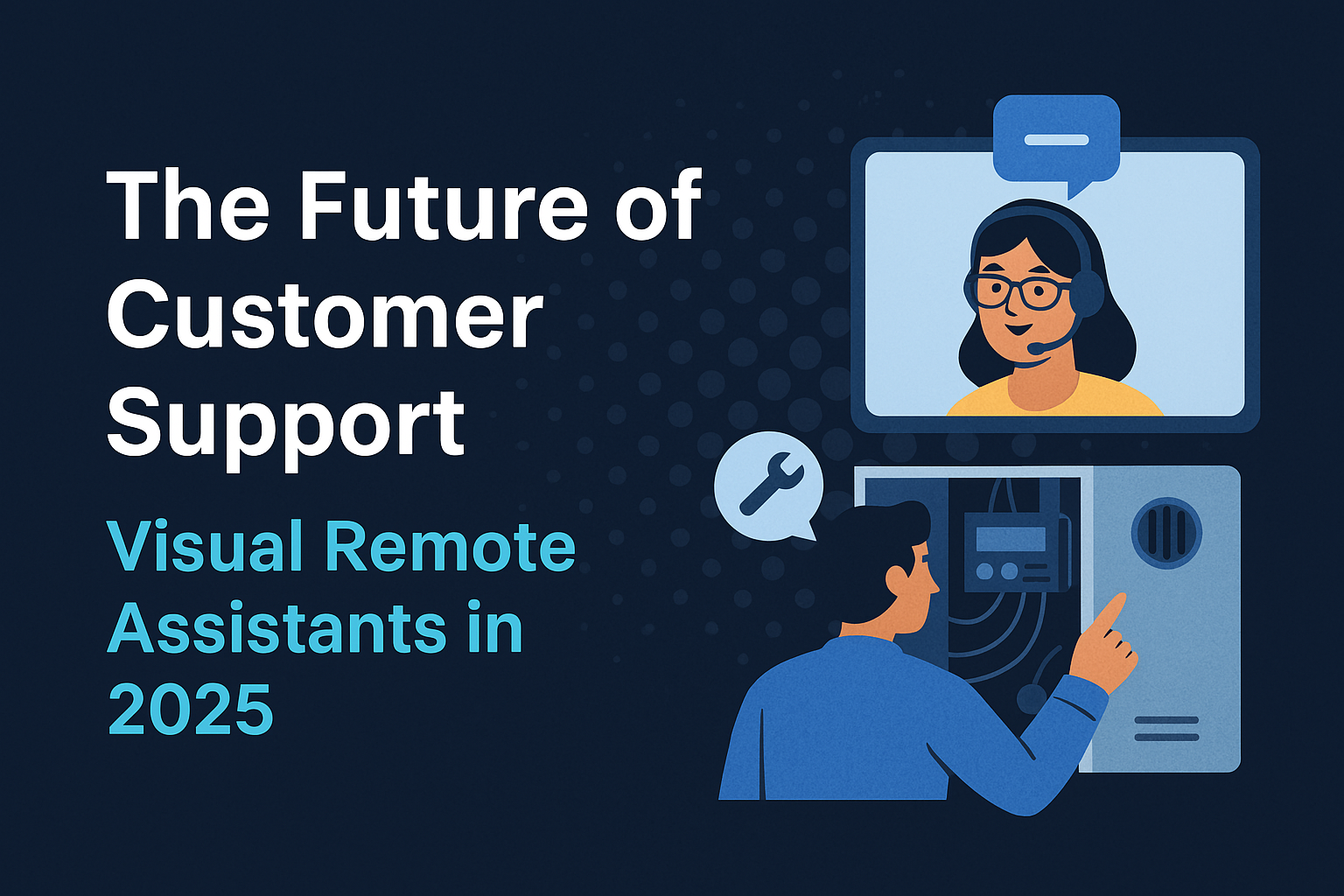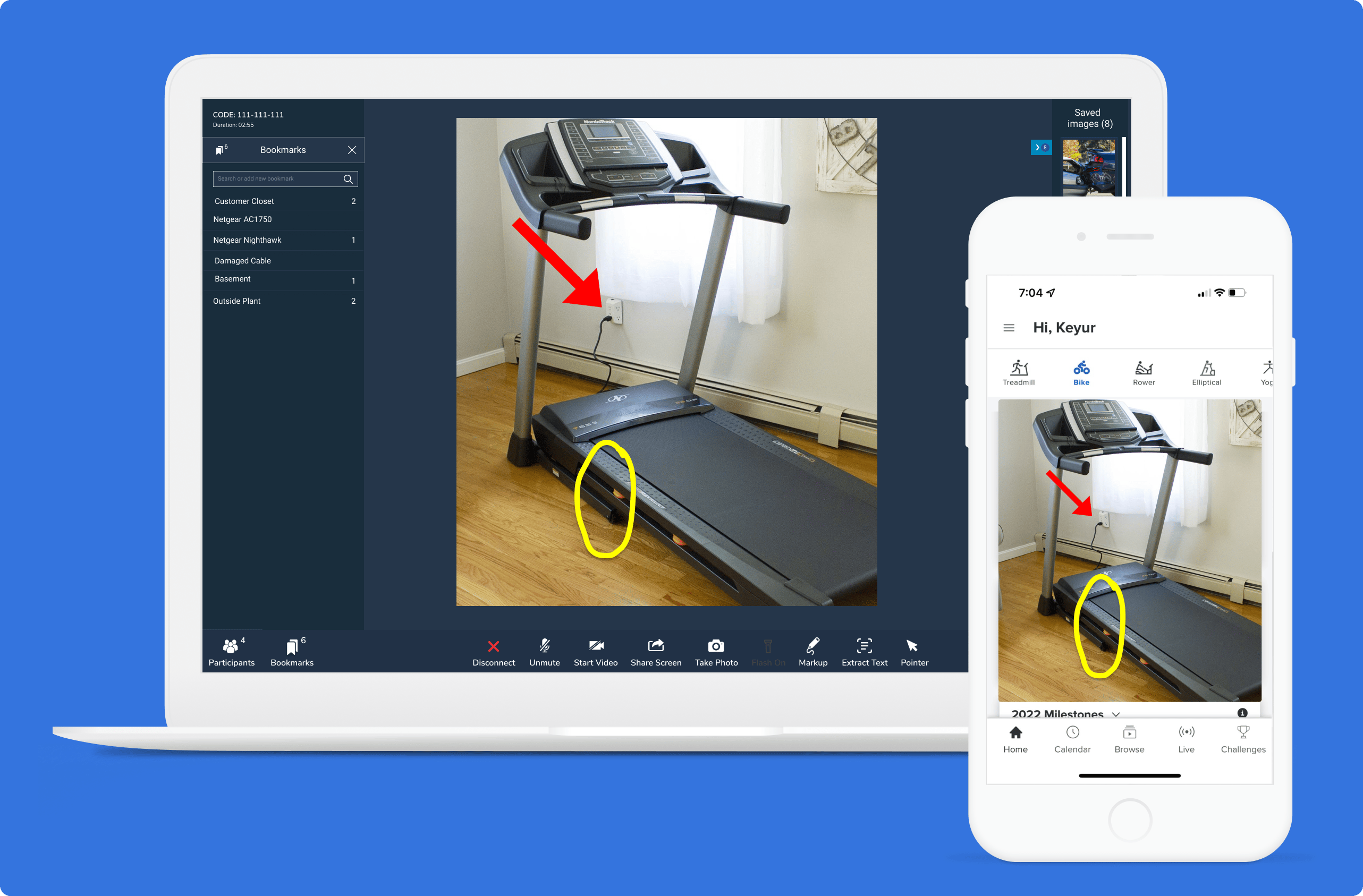Revolutionizing Field Service with AI and Augmented Reality

In a rapidly evolving world, where technology continues to shape the way we live and work, remote video assistance is emerging as a game-changer. This innovative solution has the power to revolutionize the way support is provided, making it more efficient and effective than ever before. With just a few clicks, individuals and businesses can now connect with experts remotely and receive real-time guidance and assistance, eliminating the need for on-site visits and minimizing downtime.
Whether it's troubleshooting technical issues, providing step-by-step instructions, or offering personalized guidance, remote video assistance is proving to be an invaluable tool in a wide range of industries. From healthcare to manufacturing, from customer service to field support, this technology is transforming the way we support and serve customers, improving productivity and enhancing the overall customer experience.
As the world becomes increasingly interconnected, the demand for remote video assistance is only set to grow. With its ability to bridge distances and connect individuals from all corners of the globe, this cutting-edge solution is paving the way for a more efficient and interconnected future. Say goodbye to inconvenience and hello to seamless support – the power of remote video assistance is here to stay.
Benefits of Remote Video Assistance
Remote video assistance offers a multitude of benefits that fundamentally change how businesses approach customer support and field services. One of the most notable advantages is the significant reduction in operational costs. Traditional methods often require technicians to travel to a client's location, which involves transportation expenses, time lost in transit, and potential delays in addressing the issue at hand. With remote video assistance, experts can provide guidance and support from anywhere in the world, drastically cutting down on these costs and allowing businesses to allocate resources more effectively. This not only enhances profit margins but also enables companies to offer more competitive pricing to their clients.
Another vital benefit is the improvement in response time. In industries where time is critical, such as healthcare and manufacturing, delays can have substantial consequences. By utilizing remote video assistance, organizations can engage with customers instantly, resolving issues without the need for lengthy scheduling or travel. This immediacy not only satisfies customer demands but also fosters trust and loyalty, as clients feel valued and prioritized. Furthermore, the ability to troubleshoot and provide solutions in real-time can prevent the escalation of minor issues into major problems, thereby enhancing overall operational efficiency.
Additionally, remote video assistance fosters enhanced collaboration and knowledge sharing among teams. With the ability to connect experts from different locations, organizations can enable cross-functional collaboration that was previously limited by geographic boundaries. Technicians in the field can receive guidance from specialists who might not be available on-site, allowing for a more streamlined problem-solving process. This collaborative approach not only empowers employees but also encourages continuous learning and skill development, as team members exchange insights and best practices during live interactions.
Remote Video Assistance Statistics
Understanding the impact of remote video assistance can be illuminated through compelling statistics that highlight its effectiveness. According to recent studies, businesses that implement remote video assistance report a staggering improvement in first-call resolution rates. In fact, organizations have seen an increase of up to 30% in their ability to resolve issues during the initial customer interaction. This statistic underscores the technology's capacity to provide timely and effective solutions, further emphasizing its role in enhancing customer satisfaction.
Moreover, the adoption of remote video assistance has been shown to reduce service time significantly. Reports indicate that companies employing this technology can decrease service time by approximately 50%. This reduction not only leads to greater efficiency but also allows businesses to handle a higher volume of requests. The ability to serve more customers in a shorter period without compromising the quality of service exemplifies how remote video assistance can transform operational capabilities.
Another noteworthy statistic pertains to customer satisfaction rates. Surveys have indicated that customers who utilize remote video assistance experience a satisfaction rate exceeding 90%. This high level of satisfaction is primarily attributed to the personalized and immediate support provided through video interactions. Clients appreciate the ability to connect with knowledgeable representatives who can visually guide them through challenges, creating a more engaging and effective customer service experience.
How Remote Video Assistance Works
At its core, remote video assistance utilizes advanced communication technologies to facilitate real-time interactions between service providers and customers. The process generally begins when a customer encounters an issue and initiates a request for support. This can be done through various platforms, including mobile applications, websites, or dedicated support systems. Once the request is made, the customer is connected to a qualified technician via a secure video call. This connection allows for a face-to-face conversation, providing a personal touch that traditional support methods often lack.
During the video call, the technician can guide the customer through troubleshooting steps, using visual aids to illustrate solutions effectively. For instance, through augmented reality (AR) overlays, technicians can annotate the customer's view, pointing out specific components or features while explaining necessary actions. This visual guidance not only enhances understanding but also minimizes the likelihood of miscommunication, leading to quicker resolutions. By bridging the gap between the technician's expertise and the customer's experience, remote video assistance ensures that both parties are aligned in their approach to problem-solving.
The technology behind remote video assistance incorporates secure data transmission and user-friendly interfaces, making it accessible to a wide range of users. Most systems are designed to work on various devices, including smartphones, tablets, and computers, thereby accommodating the preferences of different customers. Additionally, many platforms offer features such as screen sharing, file transfer, and session recording, which further enrich the support experience. By leveraging these technological capabilities, businesses can provide seamless and efficient assistance, enhancing both operational performance and customer satisfaction.
Implementing Remote Video Assistance in Your Business
Introducing remote video assistance into your business requires a strategic approach to ensure its successful integration. First and foremost, a thorough assessment of your current support processes is essential. Identify areas where traditional methods may be falling short, such as long response times or high operational costs. Understanding these pain points will help you establish clear objectives for implementing remote video assistance, allowing you to tailor the solution to address specific challenges effectively.
Once the objectives are defined, choosing the right technology platform is crucial. There are numerous remote video assistance solutions available, each with its unique features and capabilities. When selecting a platform, consider factors such as ease of use, compatibility with existing systems, security protocols, and customer support options. Additionally, seek feedback from your team members who will be using the technology to ensure it meets their needs and aligns with their workflows. A user-friendly platform will encourage adoption and facilitate a smoother transition to remote support.
Training is another critical component in the successful implementation of remote video assistance. Both support staff and customers need to be adequately trained to make the most of the technology. For support personnel, training should focus on the technical aspects of the platform, as well as effective communication strategies for engaging with customers remotely. On the customer side, providing clear instructions on how to initiate remote video assistance and what to expect during the process can significantly enhance the user experience. By investing in comprehensive training, businesses can maximize the potential of remote video assistance and ensure it becomes an integral part of their support strategy.
Best Practices for Remote Video Assistance
To fully harness the power of remote video assistance, organizations should adhere to several best practices that enhance the effectiveness of their support interactions. One of the foremost practices is to establish clear communication protocols. Technicians should be trained to articulate their instructions clearly and concisely, avoiding jargon that may confuse customers. Additionally, active listening is vital; technicians must ensure they understand the customer’s issue before providing solutions. By fostering an environment of open communication, organizations can build trust and facilitate smoother interactions.
Another essential practice is to leverage augmented reality (AR) capabilities where applicable. AR can significantly enhance the remote assistance experience, as it allows technicians to overlay visual instructions directly onto the customer's view. This feature not only aids in clarity but also empowers customers to follow along more effectively. Organizations should invest in AR tools and train their staff on how to utilize these resources to elevate the support experience further. By incorporating AR into remote video assistance, businesses can distinguish themselves from competitors and provide a more engaging service.
Lastly, continuous feedback and improvement mechanisms should be implemented. After each remote assistance session, gathering feedback from customers can provide invaluable insights into their experiences. This data can then be analyzed to identify trends, areas for improvement, and potential training needs for staff. Regularly reviewing these insights will enable organizations to refine their remote video assistance processes, ensuring they remain responsive to customer needs and expectations. By committing to ongoing improvement, businesses can create a culture of excellence in customer support.
Industries That Can Benefit from Remote Video Assistance
Remote video assistance is not limited to a single industry; its versatility makes it applicable across various sectors. One of the most significant beneficiaries is the healthcare industry. Medical professionals can use remote video assistance to provide consultations, follow-up care, and even training for patients. This is particularly valuable in rural or underserved areas where access to healthcare is limited. By connecting patients with doctors remotely, healthcare providers can improve patient outcomes and enhance the overall efficiency of care delivery.
Manufacturing and industrial sectors also stand to gain immensely from remote video assistance. Technicians can troubleshoot machinery issues without needing to be physically present, thus minimizing downtime and maximizing productivity. Moreover, remote assistance can facilitate training for new equipment, allowing operators to learn from experts in real-time, regardless of their location. This capability not only streamlines operations but also contributes to a safer working environment by reducing the need for experts to be on-site in potentially hazardous conditions.
Customer service and retail industries are witnessing a transformation as well, with remote video assistance enhancing the shopping experience. Retailers can offer personalized support through video calls, allowing customers to see products in real-time and receive tailored recommendations. This level of engagement not only boosts customer satisfaction but also drives sales by providing an immersive shopping experience. As more industries recognize the potential of remote video assistance, its adoption is likely to continue expanding, leading to improved service delivery and customer engagement across the board.
Tools and Technologies for Remote Video Assistance
The effectiveness of remote video assistance is heavily reliant on the tools and technologies that support it. A variety of software solutions are available, each offering distinct features designed to enhance remote interactions. For instance, platforms such as TeamViewer, Zoom, and Microsoft Teams have gained popularity for their user-friendly interfaces and robust functionalities. These tools enable video calls, screen sharing, and collaborative workspaces, making them ideal for remote assistance scenarios. Selecting the right tool requires careful consideration of your specific needs, such as security requirements, ease of integration, and scalability.
In addition to software solutions, hardware plays a crucial role in facilitating remote video assistance. High-quality cameras and microphones are essential for ensuring clear communication during video calls. Organizations should invest in reliable equipment that can capture high-definition video and audio, as this significantly enhances the overall quality of interactions. Furthermore, mobile devices equipped with good cameras can provide technicians with the flexibility to assist customers in various environments, making remote support even more accessible.
Emerging technologies such as augmented reality (AR) and artificial intelligence (AI) are revolutionizing remote video assistance. AR tools can overlay visual instructions onto the customer’s view, providing a richer and more intuitive support experience. Meanwhile, AI-driven chatbots can assist in pre-screening customer issues or managing simple queries, freeing up human agents for more complex interactions. By incorporating these advanced technologies, businesses can elevate their remote video assistance offerings, ensuring they remain competitive in an ever-evolving landscape.
Training and Certification for Remote Video Assistance
As the demand for remote video assistance grows, so does the need for comprehensive training and certification programs. Organizations must equip their staff with the knowledge and skills necessary to deliver effective remote support. Training programs should cover a range of topics, including technical proficiency in using remote assistance tools, effective communication techniques, and best practices for customer engagement. By providing thorough training, companies can ensure their employees are well-prepared to handle a variety of customer scenarios.
Certification programs can also play a pivotal role in enhancing the credibility of remote video assistance providers. By offering certifications for technicians, organizations can demonstrate their commitment to quality service and professionalism. These programs typically assess technical skills as well as customer service competencies, ensuring that certified individuals possess a well-rounded skill set. Furthermore, certification can motivate employees to pursue continuous learning, fostering a culture of excellence within the organization.
Moreover, ongoing training and development should be a priority even after initial onboarding. As technology evolves and new tools emerge, it is essential for staff to stay updated on the latest advancements in remote video assistance. Regular refresher courses, workshops, and access to online resources can provide employees with the knowledge they need to adapt to changing customer demands and technological developments. By investing in continuous training, businesses can maintain a high standard of service and adapt to the ever-changing landscape of remote support.
Conclusion: The Future of Efficient and Effective Support
The future of remote video assistance is bright, with its potential to revolutionize support services across various industries. As organizations continue to recognize the benefits of this innovative technology, its adoption is expected to grow substantially. The ability to provide immediate, personalized assistance not only enhances customer satisfaction but also improves operational efficiency. As businesses strive to meet the demands of increasingly tech-savvy consumers, remote video assistance will play a crucial role in shaping the next generation of customer support.
Furthermore, the continuous advancement of technologies such as augmented reality and artificial intelligence will only bolster the effectiveness of remote video assistance. These innovations will empower support teams to deliver even more dynamic and immersive experiences, further bridging the gap between physical and virtual interactions. As these technologies mature, businesses will find new ways to engage with customers, providing solutions that are both efficient and effective.
In conclusion, embracing remote video assistance is not just about keeping pace with technological advancements; it is about reimagining customer support to meet the needs of a rapidly changing world. By investing in the right tools, training, and best practices, organizations can position themselves at the forefront of this transformation. The future of support is here, and it is powered by the capabilities of remote video assistance, promising a more connected and responsive approach to customer service.



